10 Egrets and Herons Found in North America
Updated: Jan. 21, 2022
You probably know a great blue heron when you see it, but what about the green heron or reddish egret? Learn to identify common herons and egrets.
Unless you live on the water, you probably don’t see a lot of egrets and herons in your backyard. These are mostly wetlands birds, made for foraging in the shallows with their long leg legs and extended necks. Herons and egrets all belong to the same family (Ardiedae), which has 64 members worldwide.
In the U.S. and Canada, there are 10 heron and egret species you’re likely to find, with more found in the south. These are nearly all water birds, so look for them at the beach, along the river’s edge, and in marshy wetlands. Many of them group together to form breeding colonies, where their awkward nestlings are great fun to watch. No matter where you find egrets and herons, these large graceful birds always inspire a sense of awe.
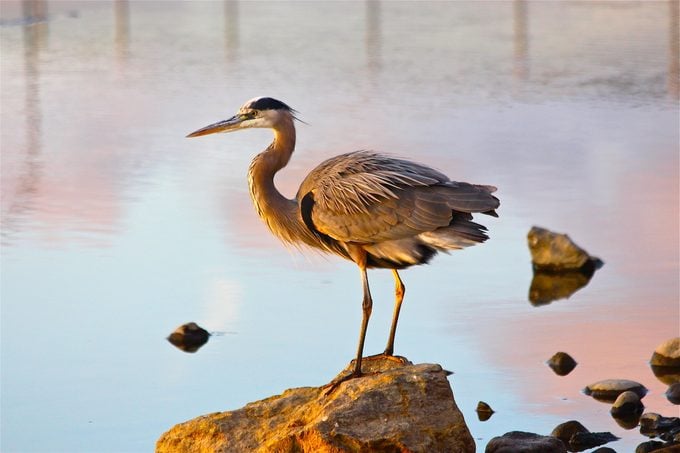
Great Blue Heron
Ardea herodias
Size: 38 – 54 inches tall, wingspan 65 – 80 inches
Great blue herons are one of the largest and most widespread wading birds in North America, found in wetlands throughout the region. They’re common in freshwater and saltwater, where they stalk the shallow shorelines for fish and crustaceans. Bluish-gray in color, these herons often stand motionless until they spot prey, when they move with lightning quick speed. Great blue herons are also one of the top 9 most beautiful birds in America.
Fascinating Fact: An all-white subspecies of the great blue heron lives in the Florida Keys.
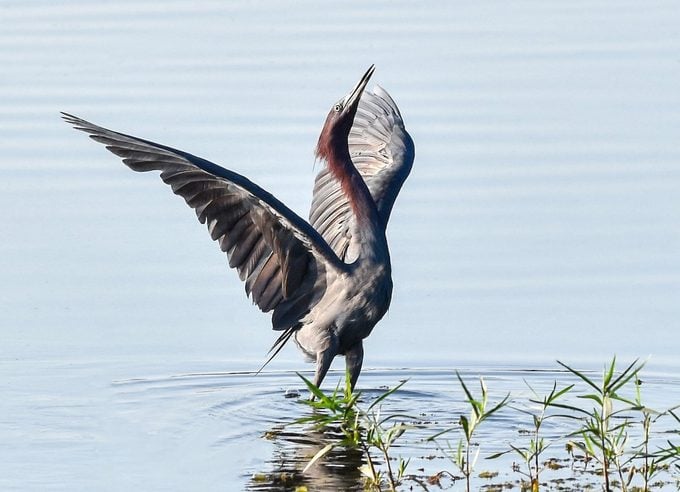
Little Blue Heron
Egretta caerulea
Size: 22 – 30 inches tall, wingspan 39 – 41 inches
Little blue herons aren’t as widespread as great blue herons, mainly being found along the eastern and gulf coastlines and the wetlands of the Southeast. They spread north along the Mississippi to breed each summer. Little blue herons forage slowly in the shallows of marshes and estuaries. They are entirely blue, with a darker blue-purple head and a two-toned bill.
Fascinating Fact: Juvenile little blue herons are completely white. They gradually grow their blue feathers over their first year, resulting in a mottled blue and white pattern during this time.
Take our quiz and see how many shorebirds you can identify.
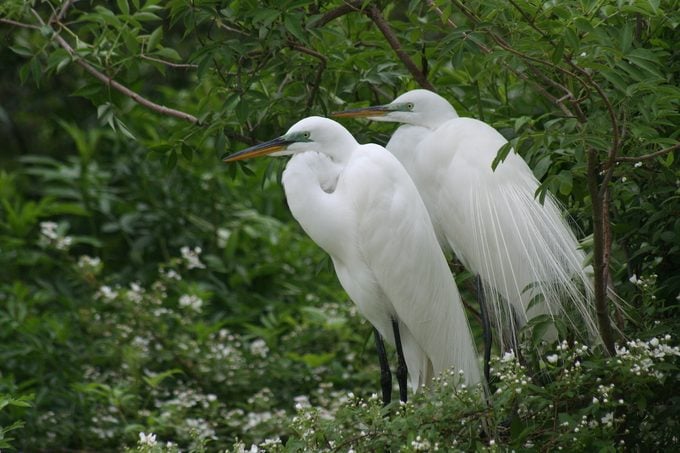
Great Egret
Ardea alba
Size: 37 – 41 inches tall, wingspan 51 – 57 inches
Slightly smaller and more sleek than great blue herons, great egrets are perhaps one of the most elegant birds of North America. Their pure white feathers are set off by shiny black legs and a long slender yellow bill. Look for them in wetlands across the country during fall and spring migration and summer breeding, and along the southern and western coasts in winter.
Fascinating Fact: In breeding season, great egrets grow spectacular feathery plumes around their tail end. They spread these feathers like a peacock and bob up and down to attract a mate.
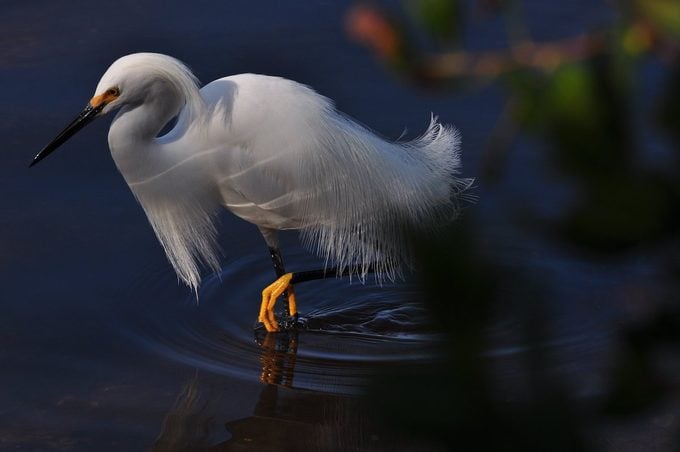
Snowy Egret
Egretta thula
Size: 22 – 26 inches tall, wingspan 40 inches
The small snowy egret is an active hunter, often striding briskly through the shallows in search of prey. Despite their similar all-white feathers, their much smaller size makes it easy to tell them apart from great egrets. The most obvious identifying feature of a snowy egret, though, is the bright yellow feet. Snowy egrets winter along the coasts and spread inland and north for breeding.
Fascinating Fact: The snowy egret was nearly extirpated in the early 20th century, when they were hunted in droves for their long breeding plumes. Populations have rebounded since the ending of the plume trade in 1910.
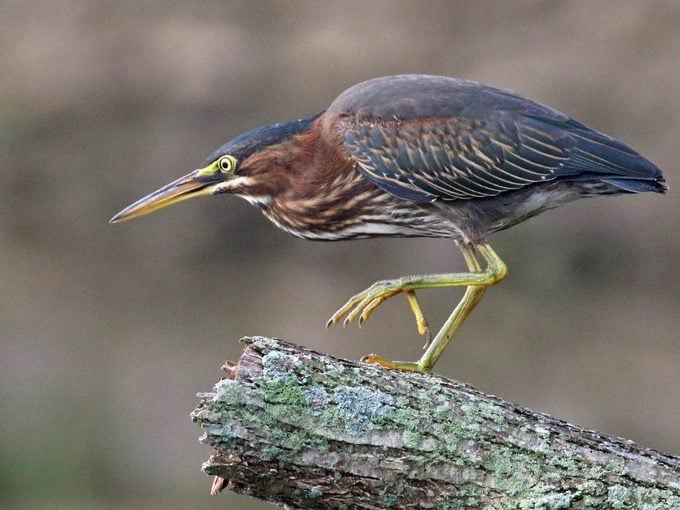
Green Heron
Butorides virescens
Size: 16 – 18 inches tall, wingspan 25 – 27 inches
The diminutive green heron is a master of camouflage, easily disappearing into the plants at the water’s edge. At rest, they hide their long heron neck by drawing it into their body. It’s only when they’re actively hunting that you’ll see the neck fully stretched out and realize it’s definitely a member of the heron family. Green herons are found in wetlands throughout the eastern part of the country, and along the western coast.
Fascinating Fact: Green herons have been spotted using tools to catch prey. They makes lures from bread crusts, earthworms, or other treats to lure small fish to the surface, where they promptly snap them up. Discover 4 types of bird beaks and how birds use them.
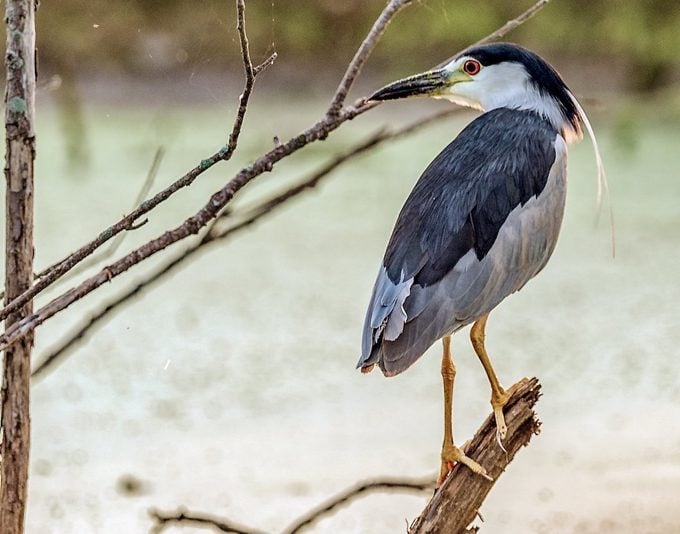
Black-Crowned Night Heron
Nycticorax nycticorax
Size: 23 – 26 inches tall, wingspan 45 – 47 inches
Night herons are active mostly from dusk to dawn, but you can still spot them during the daytime. Black-crowned night herons are stocky, often resting with their necks pulled in. They have darker gray plumage on their backs and a long white crest plume that reaches back from their heads. They have a wide range, being found in wetlands throughout most of the U.S. and parts of Canada during breeding season in the summer.
True to its name, it does a lot of its feeding at night, hunting along the water’s edge for minnows, frogs and crayfish. During the day, night-herons may simply rest in dense trees or thickets near the water.
Fascinating Fact: Juvenile black-crowned night herons are brown streaked with white. While they leave the nest after a month, they don’t learn to fly until a couple of weeks later. In the meantime, they forage the undergrowth on foot.
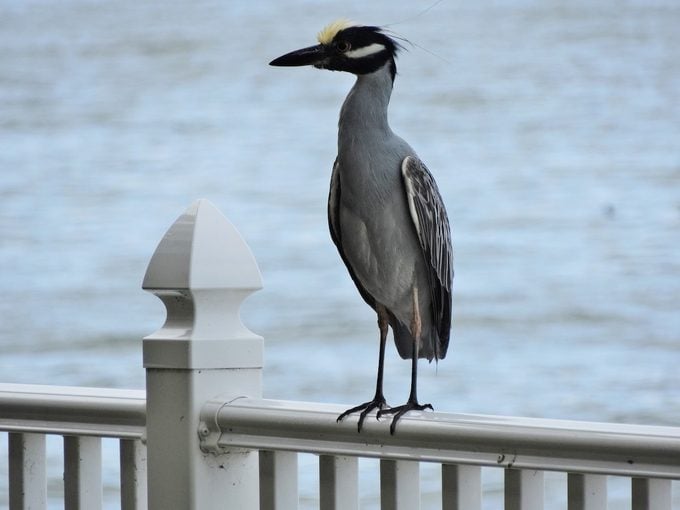
Yellow-Crowned Night Heron
Nyctanassa violacea
Size: 22 – 28 inches tall, wingspan 39 – 41 inches
Yellow-crowned night herons are more slender and less stocky than their cousins, black-crowned night herons. They sometimes pull their neck in to rest. The top of their heads boast the yellow crown and head plumes. Their range is much smaller in North America than black-crowned herons; they’re found mainly along the east and gulf coast and up into the Mississippi River valley during breeding season.
Fascinating Fact: Yellow-crowned night herons love to eat crustaceans, foraging for them before and after high tide in saltwater regions regardless of the time of day.
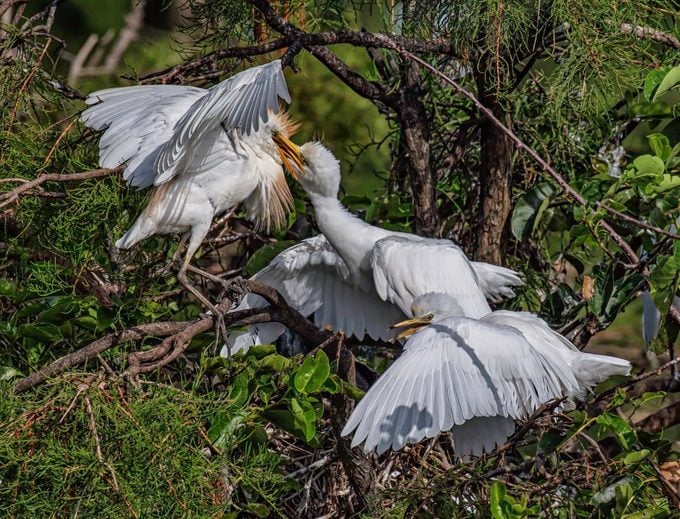
Cattle Egret
Bubulcus ibis
Size: 18 – 22 inches tall, wingspan 35 – 38 inches
Though they look a lot like great egrets for most of the year, cattle egrets are significantly smaller. They’re also rarely seen in or around water, and instead spend their time chasing insects in fields and meadows. Cattle egrets are often found around grazing animals like cows, who stir up lots of bugs for cattle egrets to eat. They live year-round in the southeast, and extend their range to the north in summer.
Fascinating Fact: Cattle egrets aren’t native to the Americas, but how they got here is a bit of a mystery. Most likely, they came across to South American in the late 1800s with shipments of cattle, and slowly spread northward, reaching the U.S. in the 1940s. Their range continues to spread.
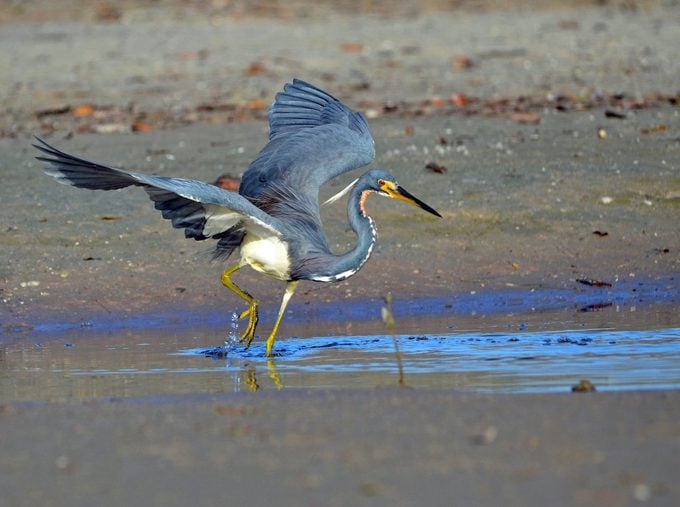
Tricolored Heron
Egretta tricolor
Size: 23 – 28 inches tall, wingspan 37 – 38 inches
Also known as the Louisiana heron, tricolored herons are found mostly in Florida and around the Gulf coast into Texas. Their bluish-gray coloration might remind you of a little blue heron, but the thin white line that runs down the front of their throat and white belly is an easy giveaway.
Fascinating Fact: Tricolored herons are active hunters, darting through the shallows and covering a lot of ground as they forage.
Next, do you know what happens to birds in a hurricane?
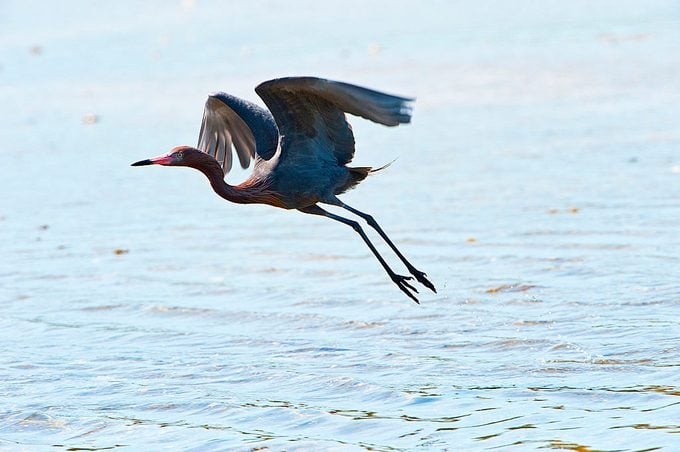
Reddish Egret
Egretta rufescens
Size: 27 – 32 inches tall, wingspan 46 – 49 inches
The reddish egret has an extremely limited range in North America, with only about 2,000 breeding pairs found mainly along the coasts in peninsular Florida, Louisiana, and Texas. They’re very entertaining to watch, as they run, jump, and leap while they hunt in the shallows. You can distinguish them from little blue herons by their obviously pinkish-red head and neck.
Fascinating Fact: Reddish egrets also have a white morph form that resembles a snowy egret. Look for the reddish egret’s two-toned bill that’s pink near the face and dark at the end.
Psst—nature lovers should travel to South Texas to see hundreds of rare butterflies!
